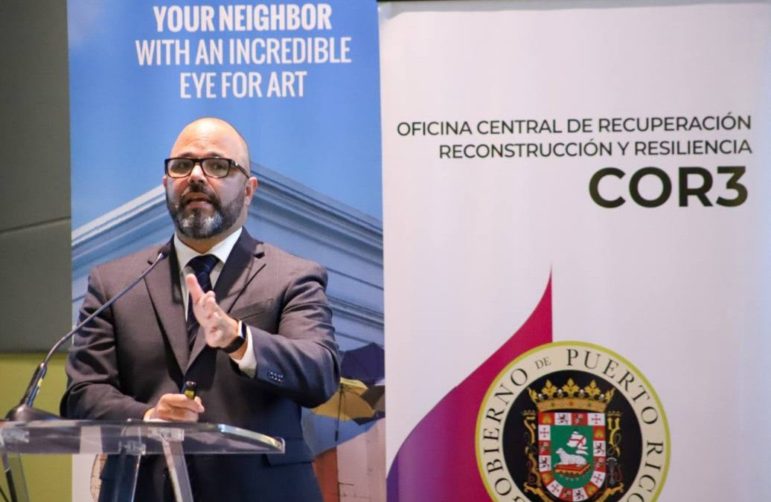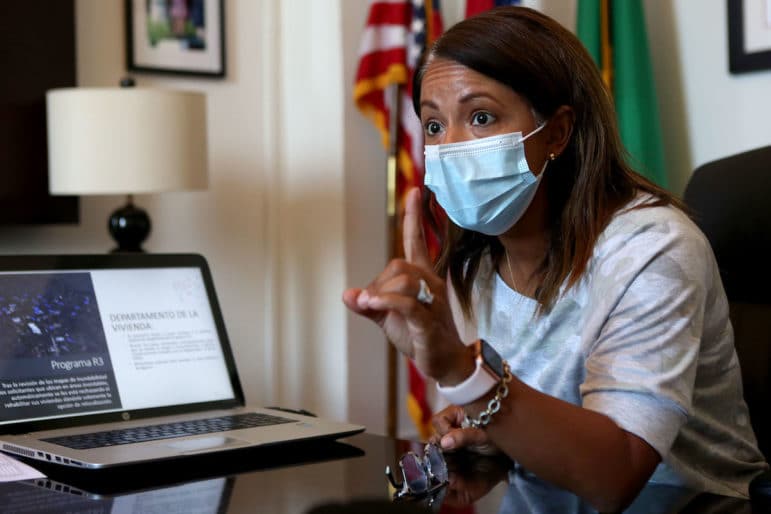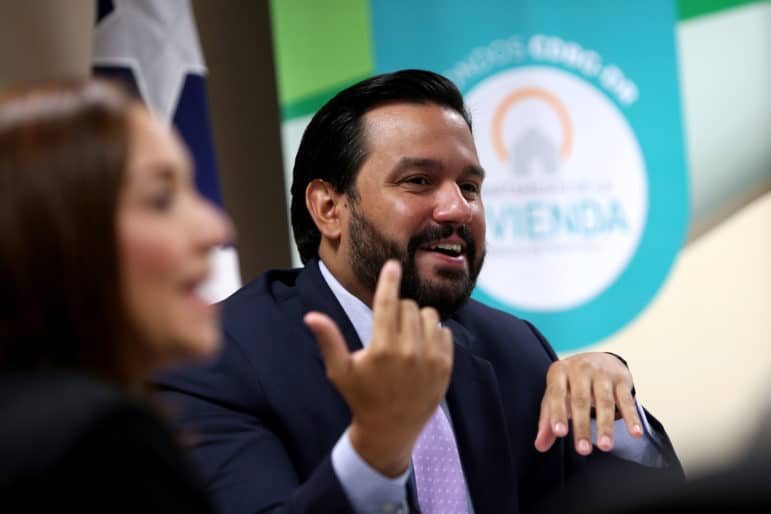The residents of the El Álamo neighborhood in Guaynabo, near the Los Frailes stream, have lived with epic flooding-related problems. After Hurricane María, the situation got worse.
As a result of these floods, the municipality, under a court ruling issued after the neighbors sued, must have an excavator ready in the area every time it rains, said Mayor Ángel Pérez Otero.
About 10 houses in the Meliá León sector, which are close to the creek, have also been affected by floods for more than three decades, according to resident Maritza Rosas, who has lived there for 62 years.
The municipality, part of the San Juan Metro Area, has a mitigation project submitted for the consideration of the Central Office of Recovery, Reconstruction and Resiliency (COR3) to build a new bridge, which would solve the problems caused by the floods. The existing bridge, which connects to the complex comprising about 200 houses, backs up quickly because of its low height, the Mayor said.
In addition to this mitigation project, the municipality of Guaynabo has another one awaiting approval. The proposal is aimed to prevent floods caused by the Guaynabo River in different areas such as Sierra Berdecia, Colinas, El Pueblo, Riberas de Honduras, Colinas Metropolitanas and the Cuita sector.
“The plans are for improvements to see how we can curtail certain erosion issues,” said Pérez, adding that “several thousand residents” are affected by this situation.
This project, he said, is further behind than the bridge in the El Álamo Urbanization. Both projects total $4.2 million in investments.
There are other 573 projects similar to this one in Guaynabo under the Hazard Mitigation Grant Program (HMGP) that are under evaluation by COR3 or the Federal Emergency Management Agency (FEMA). The program’s goal is that, after a disaster, the reconstruction done reduces the risk of loss of life and property in future disasters.
Two years after the announcement of the $4 billion allocation for risk mitigation for Puerto Rico after Hurricane María in 2017, of 592 proposals submitted to COR3 by municipalities, agencies and nonprofit organizations, FEMA has approved only 19 projects. Of those, only four are from municipalities (Hormigueros, Dorado, Loíza and Yabucoa).
This allocation is the largest in the entire United States, according to Manuel Laboy Rivera, executive director of COR3.
Among the 19 approved projects are the application of the new building codes for Puerto Rico, generators for the Hospital Menonita in Cidra, flood control in the Aguacate neighborhood of Yabucoa, and an evaluation of the condition of the coastline after María done by the University of Puerto Rico to study coastal erosion.
Pérez Otero, who also chairs the Federation of Mayors, blamed both federal and local bureaucracy for the delay in approving projects under this program. He also attributed the delay to the fact that this type of project requires further analysis and technical studies.
“These are projects that by their nature are going to take time, but the requirements imposed on us by the federal government, as well as the state government, also have an effect, since they delay the approval of the projects,” he said.
According to Laboy Rivera, having to assign priority to projects under FEMA’s Public Assistance program and a shortage of staff, are some of the reasons for the delay in mitigation projects.

Between 2017 and 2020, municipalities, government agencies and nonprofits organizations, were working on a little more than 1,500 projects classified as emergency, and at the same time designing the permanent work projects for which they requested funds, he said.
In addition, the official said that municipalities have been identifying their needs during the evaluation of their mitigation plans. Agencies and municipalities must have a FEMA-approved mitigation plan in order to get funds from the hazard mitigation program.
The mitigation program targets facilities that were not damaged and allows the funds to be used to prepare mitigation plans and cover administrative costs. It is managed by the government of Puerto Rico, specifically by COR3 and the Governor’s Authorized Representative (GAR), a position that Laboy Rivera holds.
Activities eligible under this program include the acquisition of emergency generators, storm shutters, land stabilization, construction of community shelters, flood protection, and anti-coastal erosion measures.
Laboy added that with 85% of the permanent works projects already approved, COR3 is now “in a much better position to actually move those (mitigation) projects and make them eligible.”
“Mitigation is a much broader project that does not require that anything be damaged because it’s about prevention to avoid future disasters. And that’s FEMA’s most creative part. This is the part where you make an investment toward the future. Where they say: ‘look, this doesn’t have to flood again and this doesn’t have to fall again’,” said Rafael Torrech San Inocencio, federal grants consultant who worked in the FEMA Hazard Mitigation Grant Program after Hurricane María.
Municipalities still waiting for the $2 million promised
When the allocation of funds under the mitigation program was announced in 2019, then governor, Ricardo Rosselló, said he would be assigning $1 million to each municipality to promote mitigation measures. In 2020, Gov. Wanda Vázquez announced that the amount would be increased to $2 million.
Salinas Mayor Karilyn Bonilla told the Center for Investigative Journalism (CPI, in Spanish) that when announced, the use for the $2 million was “very specific,” since the money could not be applied to any risk mitigation project. “They were for things like generators or storm shutters for critical buildings,” she said.
Salinas submitted the proposals, but as of late July the town had not yet received the funds. Bonilla added that they are still requesting information and documentation.

“There was a second phase in which the municipalities then had to develop a more detailed proposal for mitigation projects within our [municipal] mitigation plan. We submitted it [on August 8, 2019] and COR3 is still evaluating it, to pass it on to FEMA,” said Bonilla.
The director of the COR3 said the projects approved by FEMA could get going on the phases that have already been accepted. This is usually the design phase.
He reiterated that they want to move as quickly as possible because, unlike the federal Public Assistance program, in the case of the mitigation program, an eligible applicant, such as a municipality, cannot commit to or incur in expenses with the expectation of reimbursement until FEMA approves the project.
Proposals fall short
In mid-September, COR3 was evaluating 535 proposals before sending them to FEMA, and had already sent 38 to the federal agency, according to data the local agency provided.
The $4 billion in mitigation funds available for Puerto Rico comes from $3 billion in FEMA Hazard Mitigation Grant Program funds, and $1 billion in mitigation funding from the US Department of Housing (CDBG-MIT).
In an interview with the CPI in July, Laboy said the proposals they had received did not include enough that address climate change and coral protection, soil stabilization, energy, flood control, coastal erosion mitigation, so they are working on submitting proposals aimed to address these areas.
“We’ve spoken with the mayors, we open the door so that if there’s a project in this area, and if it’s significant, we’re willing to evaluate it. When we look at the list, there are many small projects, of $100,000, $200,000, and that’s good, that’s important. There are many generators, there are many safe rooms, things like that. But again, when you have $4 billion, you must think big,” said Laboy Rivera.
A safe room is a reinforced structure to provide a secure shelter from the winds and tornadoes that can occur with a hurricane. It can be built inside or outside of a building.
He added that he has a proposal from the Public Buildings Administration, which he will soon be submitting to FEMA, to address schools that were not affected by María or by the earthquakes.
He said there are projects, such as the repair of the Patillas dam, which got $2.6 million approved for the first phase of design, but the entire project is estimated at $558 million. This project, together with another from Puerto Rico Aqueduct and Sewer Authority for a filter plant, would mean a permanent solution to the access to water issues in southern Puerto Rico, Laboy Rivera assured.
FEMA also approved a project for an alert system from the Emergency Management Bureau for $5.4 million in the first phase, but the total cost of the project is estimated at nearly $120 million.
Millions pumped into reinforcing staff with new hires
Laboy Rivera said the staff shortage is another factor for the program’s delay.
“When I came in in January [2021], the staff assigned to the Hazard Mitigation program was small. I don’t think there were even five people,” he pointed out.
Now there are more than twenty people working. In addition, companies DCMC, LLC and Innovative Emergency Management (IEM) will work directly with the Hazard Mitigation program, after the Fiscal Control Board approved the contracts in May.
IEM, a stateside firm, will assist COR3 in submitting the mitigation program application packages to FEMA. The IEM contract is for up to $9.4 million for one year, through June 2022.
COR3 justified this contract. “FEMA approved an amount under the mitigation program, specifically for these types of contracts, so the contract in question is fully funded with federal funds,” he said.
DCMC, LLC also got a contract for up to $9.4 million for consulting work in areas related to the mitigation program for the same period.
“These companies are supporting the work of the twenty employees that COR3 has [in the mitigation program],” he said. “This strategy [to hire] human capital resources will allow us to be even more agile in moving the proposals that are under COR3.”
Failed to meet deadline
Although since 2018 the government has requested extensions on more than five occasions from FEMA to submit mitigation projects, as stated in documents the CPI reviewed, COR3 indicated Wednesday that it will request a new extension.
Laboy Rivera assured CPI in mid-August he would meet the deadline to submit all the projects by October 31, but if necessary, he would proceed with the extension request. To submit all the projects by October of this year, Laboy Rivera said he met with FEMA to establish a work plan.
“We now have the staff so we can meet all these needs and be able to meet the goal that FEMA has set for us that all proposals must be submitted on or before October 31 of this year. So, we’re working hard so that the rest of the proposals that haven’t been submitted can be submitted,” he said in August.
COR3 justified the new extension request saying that usually the established period of time is to manage minor disasters in contrast to the magnitude of Hurricane María, which was granted with $4 billion.
Mitigation plans almost ready
According to Laboy Rivera, the fact that the municipal mitigation plans are not yet fully updated has not represented a delay in the process.
It is a program requirement that there is an approved State Hazard Mitigation Plan in effect when FEMA awards the funds, not necessarily when the funds are requested. However, the process has been so slow that plan updates are up to date.
Updating the plans began in January 2019 and FEMA has so far approved 70 mitigation plans, according to the Planning Board’s (JP, in Spanish) website. The municipalities still pending for plans approvals are Ciales, Moca, Culebra, Hormigueros, Maunabo, Naguabo, Trujillo Alto and Guaynabo.
“Most of the municipalities had their plans and right now, the plans are either being updated or are about to expire and they have to work to update them again. I mean, they’re in that kind of ongoing process. That’s the first thing. Second, COR3 or FEMA are currently evaluating most of the proposals for the 404 Mitigation Program that we manage. So, right now, that process hasn’t been affected because there’s a municipality that needs to review its mitigation plan,” the engineer said.
In Puerto Rico, the agency responsible for updating municipal mitigation plans is the JP, which in turn hired Atkins Caribe for this work. Before Hurricane María, the municipalities were responsible for this process.
‘State’ plan didn’t contain all the prior information
FEMA approved the Puerto Rico State Natural Hazard Mitigation Plan in late July 2021. The federal agency confirmed that the plan was updated throughout and is in effect until July 29, 2026.
A total of 24 students from the University of Puerto Rico’s Graduate School of Planning at the Río Piedras Campus contributed to the plan by developing a risk profile for events such as strong winds, floods, landslides, drought, earthquake, and geological faults. These tasks were part of their academic requirements, so there was no payment.
“The academic team conducted a vulnerability analysis of six risks, considering the version of the [plan available in] 2016,” the Bureau for Emergency and Disaster Management (NMEAD, in Spanish), responsible for developing and upkeeping the state mitigation plan, confirmed in a written statement.
The interim director of the Graduate School of Planning, Norma Peña Rivera, told the CPI that the NMEAD did not have the methodology used to obtain the information published in the 2016 plan on the risk profile when it was requested, “because it was developed by an external consulting firm.”
“This happens frequently with plans that are generated for federal funds in Puerto Rico. The problem is that it’s hard to establish continuity in the analysis of the data to identify trends, and historical analyzes, among others,” said Peña Rivera, who holds a PhD in Public Policy Analysis.
The plan, also developed by COR3 staff, for the first time integrates information on the condition of Puerto Rico’s dams to access FEMA funds for their improvement.
Laboy vows not to miss out on mitigation money
Puerto Rico missed out on using $3 billion in mitigation funds between 1988 and 2019.
When the CPI asked how this situation could be prevented from happening again, Laboy Rivera said if FEMA were to not approve a project, COR3 has a list of support projects to make sure the entire $4 billion allocation is used.
“So, this time, not a single dollar is going to be left on the table,” he said.
Other mitigation funds
In addition to the $4 billion from the Mitigation Program, Puerto Rico has another $7.2 million in mitigation funds that are administered by the Puerto Rico Department of Housing. As of mid-September, FEMA also obligated about $546 million for mitigation measures under section 406, of the Stafford Act.

As for the CDBG-MIT, Housing Secretary William Rodríguez said in July there is still no project for these funds because a company has not yet been contracted to run them. He also said they are working with COR3 to avoid duplication in projects, specifically in infrastructure.